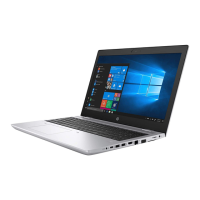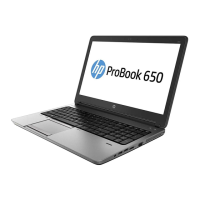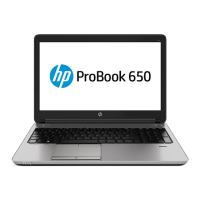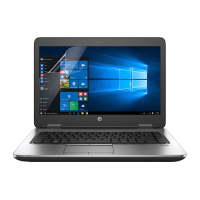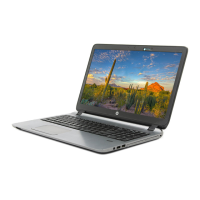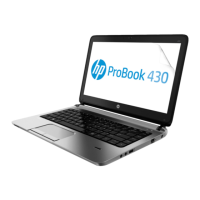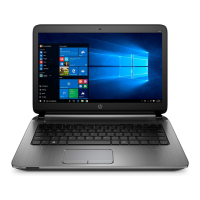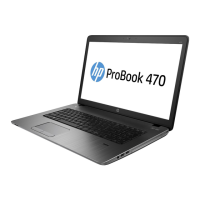Do you have a question about the HP ProBook 650 G2 and is the answer not in the manual?
Locating resources and product details within the manual.
Identification and description of components on the right side of the computer.
Identification and description of components on the left side of the computer.
Identification of display and top-side computer components and features.
Details on keyboard keys, buttons, speakers, and fingerprint reader functions.
Steps and methods for establishing a wireless network connection.
Instructions for connecting the computer to a wired network using an Ethernet cable.
Detailed explanation of touchpad gestures and pointing stick usage.
Information on keyboard usage, including shortcut and hot keys.
How to manage audio, connect speakers, headphones, and microphones.
Connecting external displays via VGA and DisplayPort, and managing display states.
Procedures for shutting down and configuring power saving modes.
Information on battery usage, charging, and maximizing battery life.
Inserting and removing memory and smart cards.
Connecting and using USB devices, including removal procedures.
Optimizing hard drive performance with Disk Defragmenter and Cleanup.
How HP 3D DriveGuard protects the hard drive from movement.
Setting and managing passwords for Windows and Computer Setup.
Using antivirus, firewall, critical updates, and HP Client Security.
Instructions for safely cleaning the computer's exterior and components.
How to update system software and drivers for optimal performance.
Creating backups of files, folders, and the entire hard drive.
Using recovery tools (Windows, f11) to restore the system.
Installing the OS using external media if recovery partitions are unavailable.
Navigating and using the BIOS setup utility for system configuration.
How to check for and install BIOS updates.
Overview of the diagnostic tool and its capabilities.
Steps to download diagnostic tools to a USB drive.
Methods for contacting HP support, including chat and phone.
Details on power requirements and ratings for the computer.
Environmental conditions for operating and non-operating the computer.
Overview of assistive technologies supported by HP products.
Where to find help and tools for troubleshooting.
Step-by-step solutions for common computer problems.
Locating resources and product details within the manual.
Identification and description of components on the right side of the computer.
Identification and description of components on the left side of the computer.
Identification of display and top-side computer components and features.
Details on keyboard keys, buttons, speakers, and fingerprint reader functions.
Steps and methods for establishing a wireless network connection.
Instructions for connecting the computer to a wired network using an Ethernet cable.
Detailed explanation of touchpad gestures and pointing stick usage.
Information on keyboard usage, including shortcut and hot keys.
How to manage audio, connect speakers, headphones, and microphones.
Connecting external displays via VGA and DisplayPort, and managing display states.
Procedures for shutting down and configuring power saving modes.
Information on battery usage, charging, and maximizing battery life.
Inserting and removing memory and smart cards.
Connecting and using USB devices, including removal procedures.
Optimizing hard drive performance with Disk Defragmenter and Cleanup.
How HP 3D DriveGuard protects the hard drive from movement.
Setting and managing passwords for Windows and Computer Setup.
Using antivirus, firewall, critical updates, and HP Client Security.
Instructions for safely cleaning the computer's exterior and components.
How to update system software and drivers for optimal performance.
Creating backups of files, folders, and the entire hard drive.
Using recovery tools (Windows, f11) to restore the system.
Installing the OS using external media if recovery partitions are unavailable.
Navigating and using the BIOS setup utility for system configuration.
How to check for and install BIOS updates.
Overview of the diagnostic tool and its capabilities.
Steps to download diagnostic tools to a USB drive.
Methods for contacting HP support, including chat and phone.
Details on power requirements and ratings for the computer.
Environmental conditions for operating and non-operating the computer.
Overview of assistive technologies supported by HP products.
Where to find help and tools for troubleshooting.
Step-by-step solutions for common computer problems.
| Form factor | Clamshell |
|---|---|
| Product type | Laptop |
| Product color | Silver |
| Country of origin | China |
| Bus type | QPI |
| Stepping | D1 |
| Tjunction | 100 °C |
| Processor cache | 3 MB |
| Processor cores | 2 |
| Processor model | i5-6200U |
| System bus rate | 4 GT/s |
| Processor family | Intel® Core™ i5 |
| Processor series | Intel Core i5-6200 series |
| Processor socket | LGA 1356 (Socket B2) |
| Processor threads | 4 |
| Processor codename | Skylake |
| Configurable TDP-up | 25 W |
| Processor frequency | 2.3 GHz |
| Processor cache type | Smart Cache |
| Configurable TDP-down | 7.5 W |
| Processor lithography | 14 nm |
| Processor manufacturer | Intel |
| Processor front side bus | - MHz |
| PCI Express slots version | 3.0 |
| Processor boost frequency | 2.8 GHz |
| Processor operating modes | 64-bit |
| ECC supported by processor | No |
| PCI Express configurations | 1x4, 4x1 |
| Thermal Design Power (TDP) | 15 W |
| Configurable TDP-up frequency | 2.4 GHz |
| Configurable TDP-down frequency | 0.8 GHz |
| Maximum number of PCI Express lanes | 12 |
| Numeric keypad | Yes |
| Pointing device | Touchpad |
| Recovery operating system | Windows 10 Pro |
| Operating system installed | Windows 7 Professional |
| Memory slots | 2x SO-DIMM |
| Internal memory | 8 GB |
| Memory clock speed | 2133 MHz |
| Internal memory type | DDR4-SDRAM |
| Maximum internal memory | 16 GB |
| Memory layout (slots x size) | 1 x 8 GB |
| SSD capacity | The Solid State Drive's storage capacity in Gigabytes. |
| SSD interface | SATA |
| Storage media | SSD |
| Optical drive type | DVD Super Multi DL |
| Total storage capacity | 128 GB |
| Compatible memory cards | SD, SDHC, SDXC |
| Number of SSDs installed | 1 |
| Display diagonal | 15.6 \ |
| Native aspect ratio | 16:9 |
| On-board graphics card ID | 1916 |
| Discrete graphics card model | Not available |
| On-board graphics card model | Intel® HD Graphics 520 |
| On-board graphics card family | Intel® HD Graphics |
| Maximum on-board graphics card memory | 1.74 GB |
| On-board graphics card OpenGL version | 4.4 |
| On-board graphics card base frequency | 300 MHz |
| On-board graphics card DirectX version | 12.0 |
| On-board graphics card dynamic frequency (max) | 1000 MHz |
| Battery capacity | 48 Wh |
| Number of battery cells | 3 |
| AC adapter power | 45 W |
| Audio system | DTS Studio Sound |
| Wi-Fi standards | 802.11a, Wi-Fi 5 (802.11ac), 802.11b, 802.11g, Wi-Fi 4 (802.11n) |
| Bluetooth version | 4.2 |
| Ethernet LAN data rates | 10, 100, 1000 Mbit/s |
| Charging port type | DC-in jack |
| USB 2.0 ports quantity | 0 |
| Sustainability certificates | ENERGY STAR |
| Processor code | SR2EY |
| Processor ARK ID | 88193 |
| Processor package size | 42 X 24 mm |
| Supported instruction sets | SSE4.1, SSE4.2, AVX 2.0 |
| Intel Smart Response Technology version | 1.00 |
| Intel Stable Image Platform Program (SIPP) version | 0.00 |
| Intel segment tagging | Enterprise |
| Depth | 257 mm |
|---|---|
| Width | 378 mm |
| Height | 27.4 mm |
| Weight | 2310 g |
